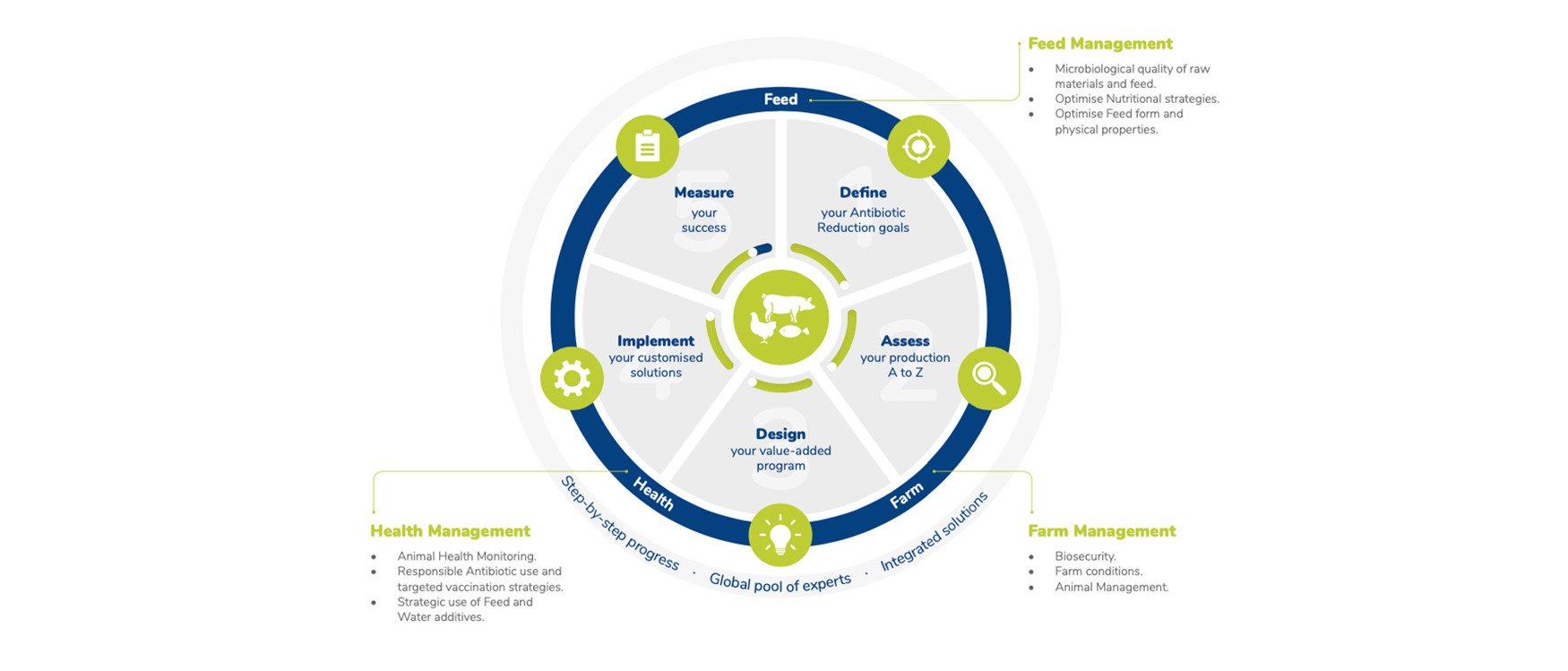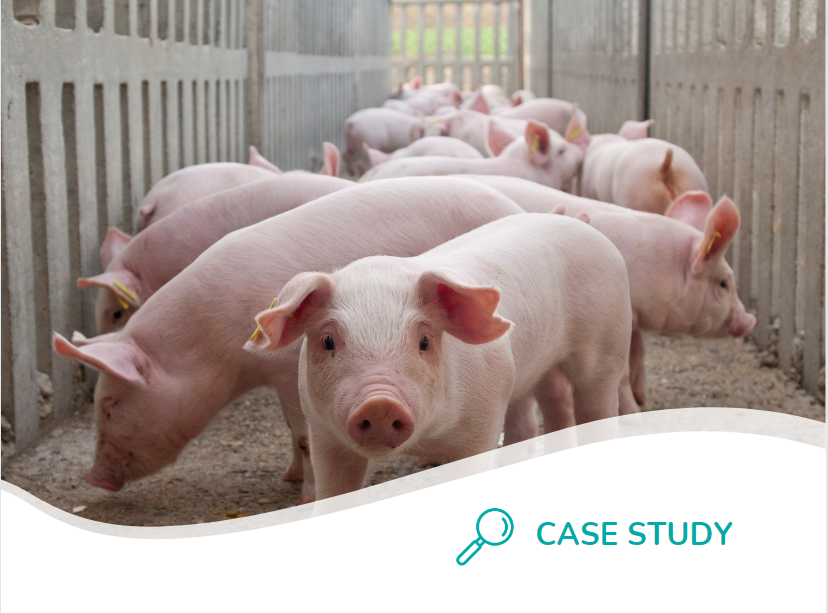Antimicrobial resistance
Antimicrobial resistance (AMR) occurs when a microorganism becomes resistant to antimicrobial agents, such as antibiotics. It is a rising problem for both humans and animals worldwide. If not tackled, it will soon become the number one global public health issue. By 2050, the United Nations (UN) estimates that 10 million deaths could be caused by AMR. At Nutreco, we are helping reduce AMR through a focus on reducing antibiotics given to animals; specifically, the most critical antibiotics for human health.
Our ambition
We are helping to tackle AMR through our Antibiotic Reduction Programme, which aims to empower producers to safely and efficiently reduce the use of antibiotics.
With a record of accomplishment spanning over 15 years, our integrated feed, farm and health approach has helped producers to achieve at least equal but, in most cases, improved productivity, while reducing antibiotic usage. Nutreco's Antibiotic Reduction Programme safeguards animal health, animal welfare and production profitability.

Our targets
- No use of antibiotics categorised by WHO* as “Critically Important" for human health (CIA) in our products and services
- No use of antibiotics for growth promotion in our products and services
- No preventive** usage of antibiotics in our products and services
- Engage with governments to promote regulatory reform
*As published in “Critically important antimicrobials for human medicine: 6th revision.”
**Ensure no preventive usage of antibiotics in our products and services. Any order of medicated premix/feed should be accompanied with a valid prescription from an authorised professional.
On February 8, 2024, WHO published the seventh revision of its list of “medically important antimicrobials”* (Updating the former “Critically important antimicrobials for human medicine: 6th revision”). This list has been created to guide antimicrobial stewardship efforts worldwide, taking into account both human and animal health, and has been aligned with the World Animal Health Association (WOAH). Starting in 2024, Nutreco will follow this new classification of antibiotics and aims for zero Critically Important Antibiotics (referred to as CIA and highest priority critically important antimicrobials (HPCIA)) by the end of 2025, according to this new classification.
* WHO publishes the WHO Medically Important Antimicrobials List for Human Medicine
Nutreco’s progress on antibiotic reduction up to 2023
In 2021, almost 99% of antibiotics in scope to be reduced by 2025 were sold at our Trouw Nutrition livestock feed business line – and more than 90% of these antibiotics were sold in five Operating Companies (OpCos). We developed a three-year project plan in 2022 that includes technical, marketing and sales strategies to reach our 2025 antibiotic-reduction targets. We focused first on monogastrics, followed by ruminants. As a result of all these efforts, we have already made good progress in reducing antibiotic usage.
Antibiotic usage: development from 2021 to 2023
|
|
|
Nutreco |
Trouw Nutrition |
Skretting |
|
CIAs |
|
- 36% |
-37% |
-24% |
|
Antibiotic growth promoters (AGP) and preventive use |
|
-29% |
-29% |
n.a. |
|
Other antibiotics |
|
-31% |
-39% |
-19% |
How do we do it?
Combating AMR is essential if we want to achieve our purpose of Feeding the Future. For that reason, Nutreco, our business lines and our OpCos engage and demonstrate their level of commitment to reducing the need for antibiotics every day.
We are helping our customers make sure that animals are raised with optimal nutrition and good welfare to increase their resilience and safeguard a healthy animal protein industry. Our five-step, integrated, step-by-step, holistic approach makes the switch to the responsible use of antibiotics easy and manageable across the full value chain.

Feed
To grow livestock in a way that is healthy and efficient, we need to maintain the delicate between animals’ nutrient requirements and the nutrients we supply them with. This guarantees that we provide animals with all the nutrients they require at any specific moment, without overloading them with excessive nutrients that could compromise their health or pollute the environment.
No two herds are the same – each comes with its own heritage, context and challenges along the lifecycle. And we will also always have variability in raw materials and their quality. To optimise nutrition, we analyse both the animal physiology at its actual health status, and the nutritional, microbiological and physical quality of the feed.
Farm
Optimising farm management is crucial to reducing antibiotics in a responsible way and improving production efficiency. In many regions, antibiotics are often used as a “safety blanket” to hide farm management risks. As production systems expand and labour scarcity intensifies across our different regions, the importance of farm management grows. Our team of experts helps producers define and improve the aspects of farm management that are most critical to reducing antibiotics successfully and producing animals efficiently and sustainably.
Health
Keeping animals healthy, which also involves managing viral and parasitic challenges, is essential for enhancing resilience and minimizing the need for antibiotics. Maintaining a healthy gut, including through the synergistic use of feed additives, is a prerequisite for overall animal health and performance, and reduces the need for antibiotics.
Case Study: Tackling AMR through local efforts
All the OpCos of our Trouw Nutrition Iberia Business Unit have made significant progress in reducing the use of antibiotics since 2010.
Despite achieving a significant reduction in the first 10 years, they have successfully minimised antibiotic use today to the minimum necessary to ensure animal welfare. The team in Iberia has reduced CIA use by 85% since 2021, and reduced non-CIA even more, by 93% since 2021, demonstrating their commitment to implementing alternatives to antibiotics.

When antibiotics are required to maintain animal well-being, veterinarian-prescribed treatments are documented with precise details, including antibiograms, sensitivity tests, indications, specific dosages and treatment durations.
Skretting continues its efforts to maintain very low antibiotic levels by offering customers value-added non-antibiotic alternatives and embracing a holistic approach to animal health, including best practices in feed, farm and health management, as they have done in previous years. However, they faced new challenges last year, resulting in some health issues that required antibiotic treatments to ensure animal welfare. Consequently, antibiotic usage increased in 2023, though it was still below 2021 levels and predominantly involved non-Critically Important Antibiotics.
This increase occurred because of climate change-induced factors, such as higher water temperatures that led to water scarcity and temperature-related fluctuations in bacterial populations. At the same time, the industry has become more vulnerable, due to vaccine companies withdrawing veterinary medicines, including vaccines, from the market. Skretting is successfully limiting the increase in antibiotics, thanks to a good cross-regional and cross-divisional collaboration, where teams learn from and assist each another in addressing the challenges. Together with Nutreco Exploration, our centre for phytogenic solutions, they develop future-oriented solutions, and partner with pharmaceutical companies to tackle these new challenges.